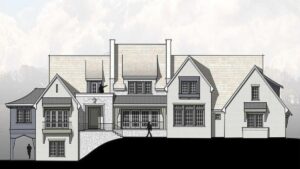Asheville is home to the biggest privately-owned residence in the U.S., a residence that exudes architectural brilliance. Local architects, like all architects, think about the design of a building or structure in terms of ordering principles. Order in architecture refers to a set of rules that define the proportions, shape, layout, and structure of a design.
Keep reading to learn more about the 6 ordering principles in architecture.
Axis
An axis in architecture is an imaginary line around which structures are symmetrically planned. It joins two points in space and is used to align design elements and plan and organize spaces.
Symmetry
Symmetry is the organization and even distribution of spaces and forms on either side of a dividing axis or plane. It can also refer to the geometry of a building—if its shape is the same on the other side of the axis when flipped. In other words, any object or structure that has a similar shape when a central line passes through it is considered symmetrical. Symmetry helps bring order, balance, and stability to a structure. Additionally, it makes a building look aesthetically pleasing.
Datum
A datum refers to a horizontal plane that serves as the reference point for measuring all vertical dimensions of a structure. A datum can be an existing feature of the site, like a road or preexisting structure that’s used as a starting point for the design of a new building. With the help of a datum, all dimensions can remain accurate and consistent from day one.
Hierarchy
Hierarchy is a system where spaces and forms are arranged and ranked in order of importance. It involves giving more priority to a room or space that has more functionality or aesthetic appeal than others and making it more noticeable.
An architect can create a hierarchy through the use of size, shape, placement, and even color. Hierarchy makes a particular form or element stand out from the overall design of a structure.
Transformation
Transformation is the principle that architectural structure, organization, or concept can be changed through a series of different manipulations without losing the originality or identity of the concept. A form that looks a bit different every time can be considered to show transformation. There are many ways shapes can transform. For instance, shapes can transform by rotating, stretching, or getting smaller or bigger in size.
Rhythm
Rhythm in architecture can be defined as the repetition of elements like forms, shapes, colors, or lines throughout the design. This results in an organized movement in time and space. By repeating elements, the intervals between the repeated elements create rhythm. Architects use rhythm to make a structure visually appealing. There are different types of rhythm in architecture. They can be flowing, progressive, alternating, regular, or random.
Innovative Architectural Designs
At Vinyet Architecture, the ordering principles of architecture inform our design proposals. So, you can be confident that we’ll deliver superior quality and innovative design solutions that meet and exceed your expectations. Want an architectural design in Asheville? Contact us today for a consultation.






